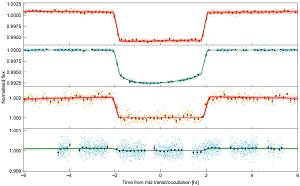Spi-OPS: Spitzer and CHEOPS confirm the near-polar orbit of MASCARA-1 b and reveal a hint of dayside reflection
- Details
- Published on 02 February 2022
Vol. 658
10. Planets and planetary systems
Spi-OPS: Spitzer and CHEOPS confirm the near-polar orbit of MASCARA-1 b and reveal a hint of dayside reflection

Knowledge of the spin-orbit misalignment of exoplanetary systems provides key constraints on their formation and evolution. Unlike spectroscopic methods (e.g., the Rossiter-McLaughlin effect) which usually only determine the sky-projected spin-orbit angle lambda, the asymmetric transit light curve of a gravity-darkened, rapidly rotating host star (where poles are brighter than the equator) may yield the true three-dimensional spin-orbit angle Psi. The method, however, requires high photometric precision and is fraught with complexity due to the interplay of several other parameters in producing the observed light curve. Hooton et al. focus here on MASCARA-1 b, an ultra-hot Jupiter for which previous transit Doppler tomography and Spitzer/IRAC 4.5 µm light curve photometry data are available. These data are combined with new CHEOPS observations of the transit and occultation of MASCARA-1 b at visible wavelengths, and they are analyzed with a physically based two-dimensional temperature model to characterize the oblate star, the misaligned planetary orbit, and the highly irradiated exoplanet atmosphere. Fitting the gravity-darkened Spitzer and CHEOPS transits together with a single set of transit parameters yields results in good agreement with the Doppler tomography, suggesting that multicolor photometry may provide a way to accurately measure Psi for many other systems. Another highlight of the work is the first joint determination of the geometric, Bond, and spherical albedos of a transiting exoplanet (here ~0.17, ~0.06, and ~0.27, respectively), which indicate that MASCARA-1 b is more reflective than most other ultra-hot Jupiters. This first joint analysis of Spitzer/IRAC and CHEOPS light curves illustrates how spectrally resolved JWST phase curve data from the visible to mid-IR will enable the separation of thermal emission and reflected light, opening the way to detailed energy budget studies of transiting exoplanets.


